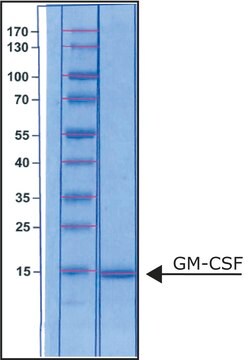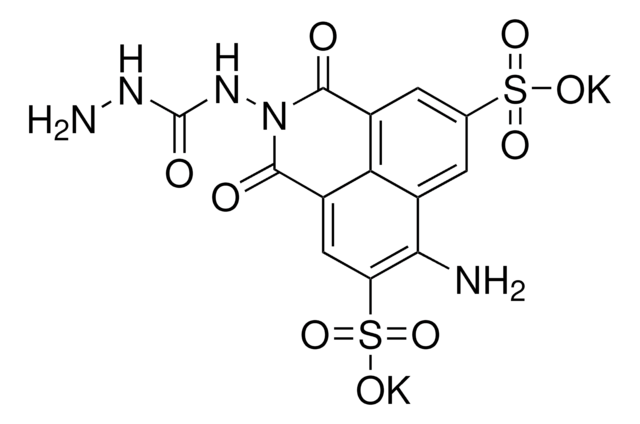Wszystkie zdjęcia(1)
Kluczowe dokumenty
M6667
Monocyte Chemotactic Protein-1 human
≥97% (SDS-PAGE and N-terminal analysis), recombinant, expressed in E. coli, lyophilized powder, suitable for cell culture
Synonim(y):
MCP-1
Zaloguj sięWyświetlanie cen organizacyjnych i kontraktowych
About This Item
Polecane produkty
pochodzenie biologiczne
human
Poziom jakości
rekombinowane
expressed in E. coli
Próba
≥97% (SDS-PAGE and N-terminal analysis)
Formularz
lyophilized powder
siła działania
5-60 ng/mL EC50
masa cząsteczkowa
8.7 kDa
opakowanie
pkg of 10 μg
metody
cell culture | mammalian: suitable
zanieczyszczenia
endotoxin, tested
numer dostępu UniProt
temp. przechowywania
−20°C
informacje o genach
human ... CCL2(6347)
Opis ogólny
Monocyte chemoattractant protein-1 (MCP-1) or monocyte chemotactic and activating factor (MCAF) is part of the C-C chemokine family. The gene encoding this protein is localized on human chromosome 17q12.
Zastosowanie
Monocyte chemotactic protein-1 (MCP-1) has been used to study its effects on the motility of lymphoblastoid cell line NC–NC cells.
Działania biochem./fizjol.
The biological activity is measured by its ability to chemoattract BaF3 mouse pro-B cells transfected with human CCR2A. The ED<SUB>50</SUB> for this effect is typically 5-30 ng/mL.
Measured by its ability to chemoattract 2-day cultured human monocytes, Matsushima, K., et al. (1989) J. Exp. Med. 169:1485, the ED<SUB>50</SUB> for this effect is typically 5-20 ng/mL.
Monocyte chemoattractant protein-1 (MCP-1) triggers the activation of monocytes by triggering degranulation as well as respiratory burst activity in monocytes. It facilitates monocytes in inhibiting or enhancing the growth of specific brain tumor cell lines. MCP-1 chemoattracts monocytes, macrophages, T cells and natural killer cells. The protein is overexpressed in atherosclerosis, idiopathic pulmonary fibrosis, rheumatoid arthritis and delayed hypersensitivity reactions. It is also implicated in Kawasaki disease.
Measured by its ability to chemoattract 2-day cultured human monocytes, Matsushima, K., et al. (1989) J. Exp. Med. 169:1485, the ED<SUB>50</SUB> for this effect is typically 5-20 ng/mL.
Monocyte chemoattractant protein-1 (MCP-1) triggers the activation of monocytes by triggering degranulation as well as respiratory burst activity in monocytes. It facilitates monocytes in inhibiting or enhancing the growth of specific brain tumor cell lines. MCP-1 chemoattracts monocytes, macrophages, T cells and natural killer cells. The protein is overexpressed in atherosclerosis, idiopathic pulmonary fibrosis, rheumatoid arthritis and delayed hypersensitivity reactions. It is also implicated in Kawasaki disease.
Postać fizyczna
Lyophilized from a 0.2 μm filtered solution in phosphate buffered saline containing 0.5 mg bovine serum albumin.
Ta strona może zawierać tekst przetłumaczony maszynowo.
Kod klasy składowania
11 - Combustible Solids
Klasa zagrożenia wodnego (WGK)
WGK 2
Temperatura zapłonu (°F)
Not applicable
Temperatura zapłonu (°C)
Not applicable
Środki ochrony indywidualnej
Eyeshields, Gloves, type N95 (US)
Wybierz jedną z najnowszych wersji:
Masz już ten produkt?
Dokumenty związane z niedawno zakupionymi produktami zostały zamieszczone w Bibliotece dokumentów.
99mTc-HMPAO labelling inhibits cell motility and cell proliferation and induces apoptosis of NC?NC cells
Mutation Research. Genetic Toxicology and Environmental Mutagenesis, 631(2), 69-76 (2007)
Interleukin 7 receptor a chain (IL7R) shows allelic and functional association with multiple sclerosis
Simon G Gregory
Nature Genetics, 39(9) (2007)
Expression of monocyte chemoattractant protein-1 in Kawasaki disease: the anti-inflammatory effect of gamma globulin therapy.
Asano T and Ogawa S
Scandinavian Journal of Immunology, 51(1), 98-103 (2000)
Monocyte Chemoattractant Protein-1 (MCP-1/CCL2) Levels and Its Association with Renal Allograft Rejection.
Raza A
Immunological Investigations, 46(3), 251-262 (2017)
Produkty
Lipid Induced Insulin Resistance
Nasz zespół naukowców ma doświadczenie we wszystkich obszarach badań, w tym w naukach przyrodniczych, materiałoznawstwie, syntezie chemicznej, chromatografii, analityce i wielu innych dziedzinach.
Skontaktuj się z zespołem ds. pomocy technicznej








